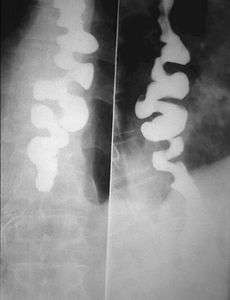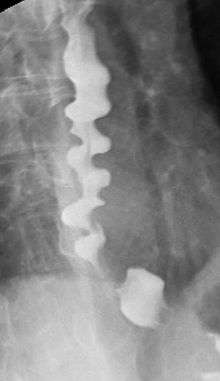Diffuse esophageal spasm
| Diffuse esophageal spasm | |
|---|---|
 | |
| Classification and external resources | |
| ICD-10 | K22.4 |
| ICD-9-CM | 530.5 |
| DiseasesDB | 32060 |
| MedlinePlus | 000289 |
| eMedicine | med/743 |
| MeSH | D015155 |
Diffuse esophageal spasm (DES) is a condition characterized by uncoordinated contractions of the esophagus, which may cause difficulty swallowing (dysphagia) or regurgitation. In some cases, it may causes symptoms such as chest pain, similar to heart disease. The cause of DES remains unknown.
Certain abnormalities on x-ray imaging are commonly observed in DES, such as a "corkscrew" or "rosary bead esophagus," although these findings are not unique to this condition. Specialized testing called manometry can be performed to evaluate the motor function of the esophagus, which can help identify abnormal patterns of muscle contraction within the esophagus that are suggestive of DES. The treatment of DES consists primarily of medications, such as acid suppressing agents (like proton pump inhibitors), calcium channel blockers, or nitrates. In only extremely rare cases, surgery may be considered. People with DES have higher incidences of gastroesophageal reflux disease (GERD) and anxiety.
Signs and symptoms
DES manifests as intermittent difficulty swallowing (dysphagia) for solid foods and liquids, and atypical chest pain. The chest pain may appear similar to cardiac chest pain (angina pectoris), so investigating the possible existence of heart disease is often indicated.[1]
Causes
Causes of diffuse esophageal spasm are not well understood. It is thought, however, that many cases are caused by uncontrolled brain signals running to nerve endings. Therefore, suppression medication is often the first line therapy such as anti depressants and anti-epileptic medication are prescribed. It has also been reported that very cold or hot beverages can trigger an esophageal spasm, and avoidance therapy benefits some people, but it has not been medically proven.
Radiography

Several radiographic findings are suggestive of DES, such as a "rosary bead esophagus" or "corkscrew" appearance on barium swallow x-ray, although these findings are not unique to DES.[1]
Treatment
Several drugs are used to treat DES, including nitroglycerin, calcium channel blockers, hydralazine, and anti-anxiety medications.[1] Acid suppression therapy, such as proton pump inhibitors, are often the first line therapy. Botulinum toxin, which inhibits acetylcholine release from nerve endings, injected above the lower esophageal sphincter may also be used in the treatment of DES. Small studies have suggested benefit from endoscopic balloon dilation in certain patients, but all of the above have a low percentage of success in treating the condition; whilst the treatments work in some sufferers, it does not work for everyone.[2] In extremely rare cases, surgery may be considered.[1]